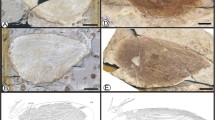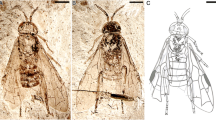Abstract
A new species of Neuroptera, Sophogramma lii sp. nov. is described and illustrated in this paper. This new species is assigned to Sophogramma Ren of Kalligrammatidae, mainly based on its humeral recurrent veins, the basal cell present between posterior branch of media at base of wing, etc. The new species is distinguished from all other Sophogramma species on the difference of wing venation. This exceptionally well-preserved specimen is recovered from the Yixian Formation, Huangbanjigou, located near Beipiao City, in western Liaoning Province. The genus diagnosis has been emended based on new characters shown in this new species. Based on a summary of localities, distribution and geological ages of all genera and species of the Kalligrammatidae, we suggest that Kalligrammatids might have originated in Eastern Asia, especially in China. Function of the wing pigmentation is discussed briefly.
Similar content being viewed by others
References
Ponomarenko A G. Neuroptera from the Jurassic in eastern Asia. Paleontol J, 1985, 18(3): 59–69
Walther J. Die Fauna der Solnhofener Plattenkalke. -Denkschriften der Medizinisch-N aturwissenschaftlichen Gesellschaft zu Jena, 1904, 11: 133–214
Panfilov D V. Kalligrammatidy (Neuroptera, Kalligrammatidae) iz yurskikh otlozhenii Karatau [=Kalligrammatids (Neuroptera, Kalligrammatidae) from the Jurassic deposits of Karatau]. In: Rohdendorf B B, ed. Yurskie nasekomye Karatau [=Jurassic insects of Karatau]. Otdelenie Obshchej Biologii: Moskva (Akademiya Nauk SSSR), 1968, 166–174 [in Russian]
Handlirsch A. Die fossilen Insekten und die Phylogenie der rezenten Formen. Leipzig: Wilhelm Engelmann, 1908. 610–612
Panfilov D V. Novye predstaviteli setcharokrylykh (Neuroptera) iz yury Karatau [=New representatives of lacewings (Neuroptera) from the Jurassic of Karatau]. In: Dolin V G, Panfilov D V, Ponomarenko A G, et al. Iskopaemye nasekomye mezozoya [=Fossil insects of the Mesozoic] (in Russian). Naukova Dumka: Kiev (Akademiya Nauk Ukrainskoj SSR, Institut Zoologii), 1980. 82–111
Handlirsch A. Eine neue Kalligrammide (Neuroptera) aus dem Solnhofen Plattenkalke. Senkenbergiana, Frankfurt a M, 1919, 1: 61–63
Ren D, Guo Z G. On the new fossil genera and species of Neuroptera from Late Jurassic of Northeast China. Acta Zootax Sin, 1996, 21(4): 461–480
Ren D, Oswald D. A new genus of Kallihemerobiidae from the Middle Jurassic of China (Neuroptera). Stuttgarter Beitrage zur Naturkunde, 2002, Ser B, 317: 1–8
Ren D. Two New Jurassic genera of kalligrammatids from Beipiao, Liaoning (Neuroptera, Kalligrammatidae) ((in Chinese English abstract). Acta Zootax Sin, 2003, 28(1): 105–109
Zhang J F. Kalligrammatid lacewings from the Upper Jurassic Daohugou Formation in Inner Mongolia, China. Acta Geol Sin, 2003, 77: 141–147
Scudder S H. A review of Mesozoic cockroaches. Mem Boston Soc Nat Hist, 1886, 3(8): 439–485
Cockerell T D A. The Jurassic insects of Turkestan. Psyche, 1928, 35(2): 126–130
Martynova O M. Kalligrammatidae (Setchatokrylye) iz yurskikh slantsev Kara-Tau (Kazakhskaya SSR) [=Kalligrammatidae (Neuroptera) from Jurassic shales of Kara-Tau (Kazakh SSR)] (in Russian). Moskva, Doklady Akademii Nauk SSSR (N.S.), 1947, 58: 2055–2068
Martynova O M. Superorder Neuropteroidea. In: Davis D R, ed. Fundamentals of Paleontology. Washington, D.C. (Smithsonian Institution Libraries and The National Science Foundation), 1962. 383–404
Ponomarenko A G. Neuroptera (Insecta) from the Lower Cretaceous of Transbaykalia. Paleontol J, 1992, 26(3): 56–66
Whalley P E S. Mesozoic Neuroptera and Raphidioptera (Insecta) in Britain. Bull Br Mus (Nat Hist) Geol, 1988, 44(1): 45–63
Carpenter E M. Treatise on Invertebrate Paleontology. Lawrence/Kansas. Geol Soc Am Univ Kansas, 1992, 4: 338–356
Lambkin K J. Palparites deichmuelleri Handlirsch from the Tithonian Solnhofen Plattenkalk belongs to the Kalligrammatidae (Insecta: Neuroptera). Palaontol Z, 1994, 68: 163–166
Jarzembowski E A. A new wealden fossil lacewing. In: Rowlands M L, ed. Tunbridge Wells and Rusthall Commons, a History and Natural History. Tunbridge Wells Museum and Art Gallary, 2001. 48–58
Zhang J F, Zhang H C. Kalligramma jurarchegonium sp. nov. (Neuroptera: Kalligrammatidae) from the Middle Jurassic of northeastern China. Oriental Insects, 2003, 37: 301–308
Michael S Engel. A remarkable kalligrammatid lacewing from the Upper Jurassic of Kazakhstan (Neuroptera: Kalligrammatidae). Trans Kansas Acad Sci, 2005, 108: 59–62
Ren D, Guo Z G, Lu L W, et al. A further contribution to the knowledge of the Upper Jurassic Yixian Formation in western Liaoning (in Chinese English abstract). Geol Rev, 1997, 43: 449–459
Zheng S L, Zheng Y J, Xing D H. Characteristics, age and climate of late Jurassic Yixian flora from western Liaoning (in Chinese English abstract). J Stratigr, 2003, 27, 233–241
Chen PJ, Wang Q F, Zhang H C, et al. Discussion on the stratotype of Jianshangou of Yixian Formation (in Chinese). Sci China Ser D-Earth Sci, 2004, 34: 883–895
Wang W L, Zhang L J, Zheng S L, et al. The age of the Yixian Stage and the boundary of Jurassic-Cretaceous e the establishment and study of stratotypes of the Yixian Stage (in Chinese English abstract). Geol Rev, 2005, 51: 234–242
Swisher C C, Wang Y Q, Wang X L, et al. Cretaceous age for the feathered dinosaurs of Liaoning, China. Nature, 1999, 400: 58–61
Zhou Z H, Barrett P M, Hilton J. An exceptionally preserved Lower Cretaceous ecosystem. Nature, 2003, 421: 807–814
Wedmann S, Makarkin V N. A new genus of Mantispidae (Insecta: Neuroptera) from the Eocene of Germany, with a review of the fossil record and palaeobiogeography of the family. Zool J Linn Soc, 2007, 149: 701–716
Makarkin V N, Menon F. First record of fossil ‘rapismatid-like’ Ithonidae (Insecta, Neuroptera) from the Lower Cretaceous Crato Formation of Brazil. Cretaceous Res, 2007, 28(5): 743–753
Liu Y S, Sinitshenkova N D, Ren D. A new genus and species of stonefly (Insecta: Plecoptera) from the Yixian Formation, Liaoning Province, China. Cretaceous Res, 2007, 28(2): 322–326
Shen Y B, Chen P J, Huang D Y. Age of the fossil conchostracans from Daohugou of Ningcheng, Inner Mongolia. J Stratigr, 2003, 27(4): 311–313
Gao K Q, Shubin N H. Earliest known crown-group salamanders. Nature, 2003, 422: 424–428
Ji Q, Yuan C X. Discovery of two kinds of protofeathered pterosaurs in the Mesozoic Daohugou Biota in the Ningcheng region and its stratigraphic and biologic significance (in Chinese English abstract). Geol Rev, 2002, 48: 221–224
Ding Q H, Zhang L D, Guo S Z, et al. The stratigraphic sequence and fossil bearing horizon of the Yixian Formation in western Liaoning, China (in Chinese English abstract). Geol Resour, 2001, 10(4): 193–198
David G, Michael S E. Evolution of the Insects. New York: Cambridge University Press, 2005. 335–351
Graeme D R, Michael P S. A taste for mimicry, Nature, 2005, 433: 205–207
Ren D, Yin J C. New ‘osmylid-like’ fossil Neuroptera from the Middle Jurassic of Inner Mongolia, China. J New York Entomol. Soc, 2003, 111: 1–11
Sam W H, David M Martill, Robert F Loveridge. An exceptionally preserved antlion (Insecta, Neuroptera) with colour pattern preservation from the cretaceous of Brazil. Palaeontol, 2005, 48: 1409–1417
Archibald S B, Makarkin V N. Tertiary giant lacewings (Neuroptera: Polystoechotidae): Revision and description of new taxa from western North America and Denmark. J Syst Palaeontol, 2006, 4(2): 119–155
Ren D, Michael S E. Aetheogrammatidae, a new family of lacewing from the Mesozoic of China (Neuroptera: Myrmeleontiformia). J Kansas Entomol Soc, 2008, 81(3): 161–167
Cai W Z, Li S J, Mi Q S. The diversity of insect mimicry (in Chinese English abstract). Entomol Knowl, 2002, 39(5): 390–397
Daniel W F, Jason N. Batesian mimics influence mimicry ring evolution. Proc Roy Soc B, 2004, 271: 191–196
James M, Mathieu J. Evolution of diversity in warning color and mimicry: polymorphisms, shifting balance, and speciation. Annu Rev Ecol Syst, 1999, 30: 201–233
Robert B S. Locomotor mimicry in heliconius butterflies: contrast analyses of flight morphology and kinematics. Phil Trans R Soc Lond B, 1999, 354: 203–214
Author information
Authors and Affiliations
Corresponding authors
Additional information
Supported by National Natural Science Foundation of China (Grant Nos. 30430100 and 40872022), Beijing Natural Science Foundation Program (Grant No. 5082002), Scientific Research Key Program (Grant No. KZ200910028005) and PHR Project of of Beijing Municipal Commission of Education, Science-Technology Basic Condition Platform from the Ministry of Science and Technology of the People’s Republic of China (Grant No. 2005DKA21402)
About this article
Cite this article
Yang, Q., Zhao, Y. & Ren, D. An exceptionally well-preserved fossil Kalligrammatid from the Jehol Biota. Chin. Sci. Bull. 54, 1732–1737 (2009). https://doi.org/10.1007/s11434-009-0284-2
Received:
Accepted:
Published:
Issue Date:
DOI: https://doi.org/10.1007/s11434-009-0284-2




